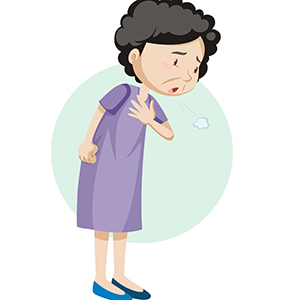Acute effect of oxygen therapy on exercise tolerance and dyspnea perception in ILD patients

Accepted: September 6, 2021
All claims expressed in this article are solely those of the authors and do not necessarily represent those of their affiliated organizations, or those of the publisher, the editors and the reviewers. Any product that may be evaluated in this article or claim that may be made by its manufacturer is not guaranteed or endorsed by the publisher.
Authors
Ambulatory oxygen therapy (AOT) is commonly prescribed in interstitial lung disease (ILD) patients, with the aim of reducing dyspnea and increasing exercise tolerance. Despite its frequent use and a reasonable physiological rationale, there is a lack of evidence supporting the effect of AOT on improving dyspnea during exercise. Moreover, dyspnea encompasses distinct sensory (intensity, quality) and affective (anxiety, fear) components with different underlying neurophysiological mechanisms. The aim of this study was to evaluate the effect of oxygen supplementation on exercise tolerance and dyspnea in ILD patients with exercise induced hypoxia (EIH). Forty-seven ILD patients performed a six-minute walk test (6MWT) on room air (RA) and with oxygen supplementation (Ox). The 6MWT distance (6MWD) was significantly greater with oxygen supplementation (RA: 242±143 m vs Ox: 345±106 m p<0,01). With oxygen supplementation, the overall dyspnea and anxiety significantly decreased both at rest [1.1±1.4 Borg Unit (BU)] vs 0.4±0.9BU, p.<0.01, and 1.1±1.6BU vs 0.5±1.3 BU, p.<0.05, respectively) and at the end of exercise (5.1±2.6 BU vs 3.7±2.5 BU, p<0.001 and 3.4 ±2.9 vs 2.5±2.8, p.<0.01, respectively) despite a greater walked distance. In ILD patients with EIH, oxygen supplementation increases the exercise tolerance and reduces overall dyspnea perception and the anxiety component of breathlessness.
Supporting Agencies
noneHow to Cite

This work is licensed under a Creative Commons Attribution-NonCommercial 4.0 International License.
PAGEPress has chosen to apply the Creative Commons Attribution NonCommercial 4.0 International License (CC BY-NC 4.0) to all manuscripts to be published.

 https://doi.org/10.4081/monaldi.2021.1925
https://doi.org/10.4081/monaldi.2021.1925




